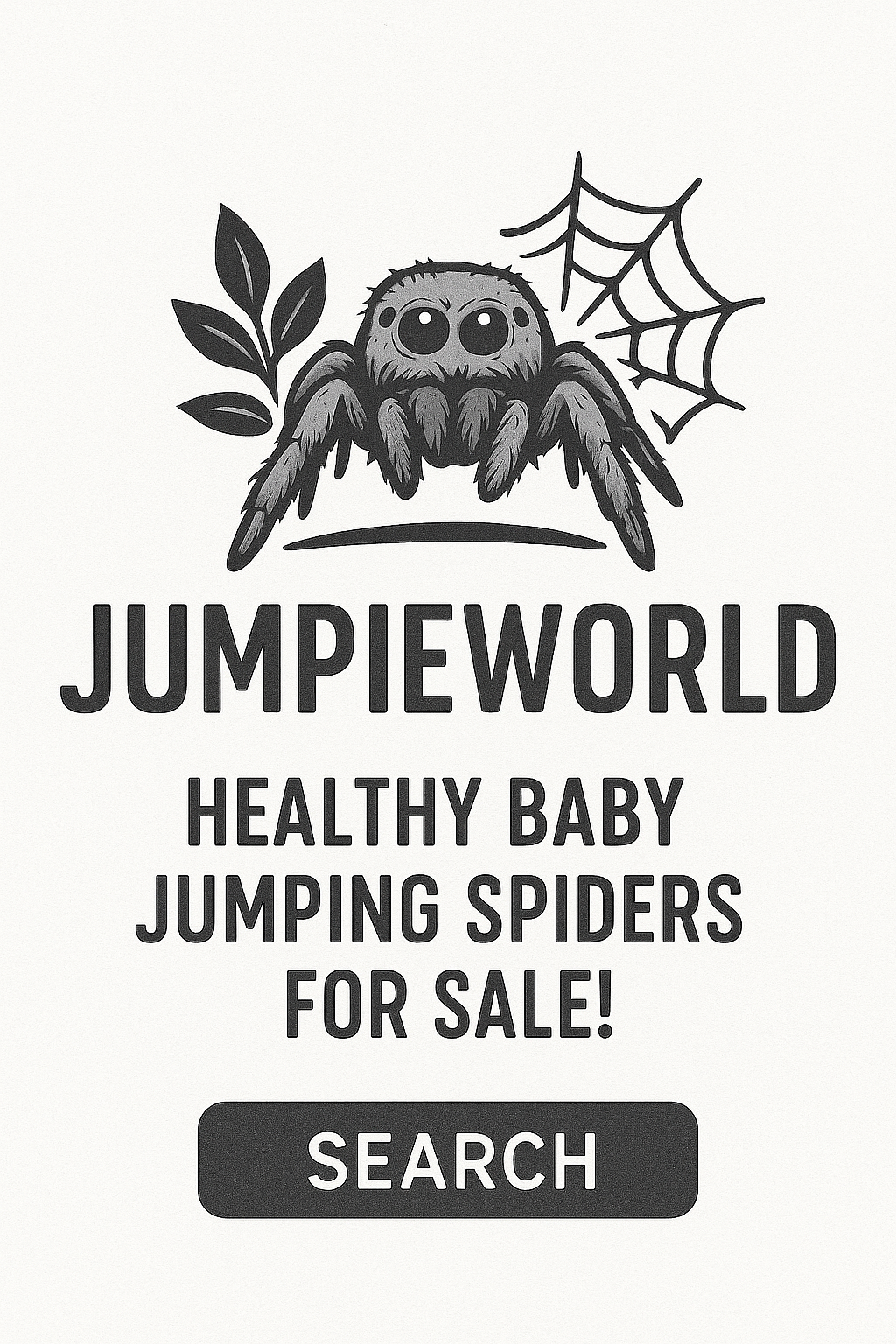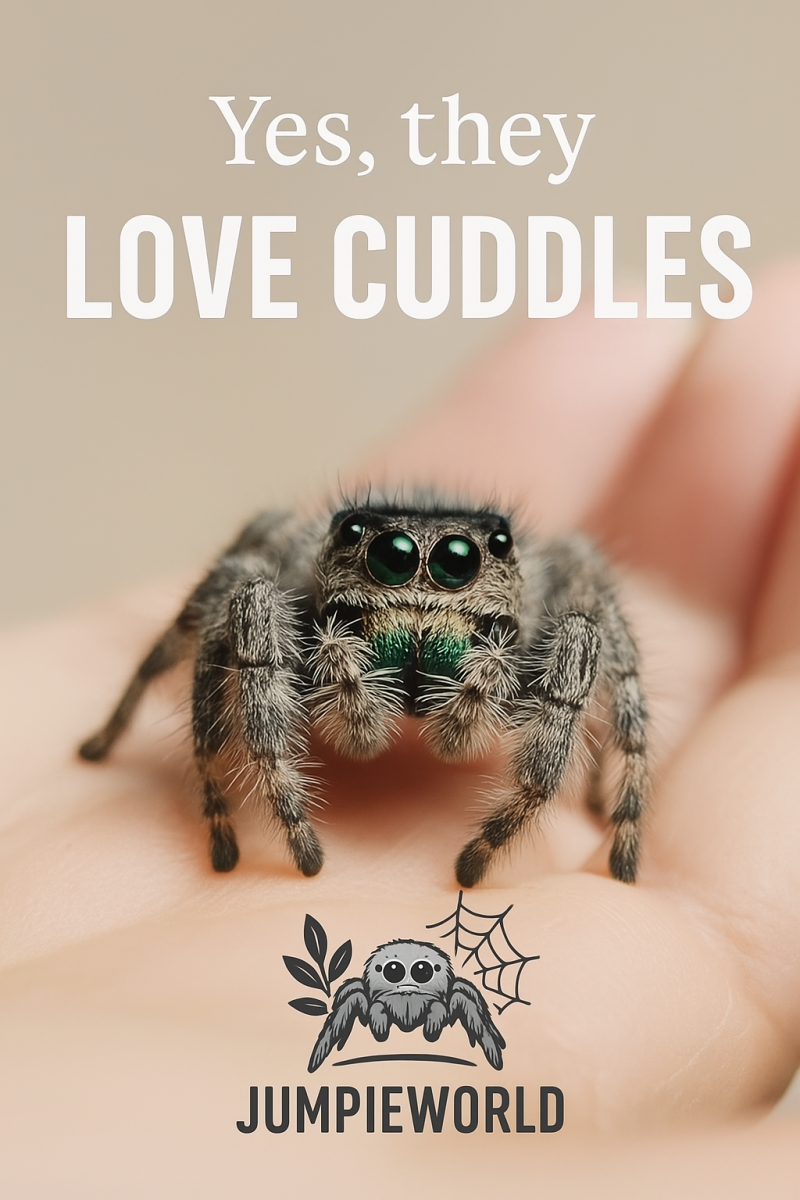

About us
At JumpieWorld.com, we’re dedicated to breeding and selling high-quality baby jumping spiders. Our mission is to connect people with these amazing, intelligent creatures in a responsible and ethical way. Every spider is carefully raised in a safe, clean environment. Explore our collection and find the perfect little jumper to brighten your home.
Explore our jumpies
At JumpieWorld, every baby jumping spider is raised with care and attention to ensure health, comfort, and quality. Browse our collection to find your ideal Jumpie and start your journey into the fascinating world of these remarkable little creatures.
Phidippus regius – The Regal Jumper
Known for their bright colors, curious nature, and bold personalities, Phidippus regius are true stars of the jumping spider world. Each one is carefully raised for health, friendliness, and vibrant beauty. Whether you’re a first-time keeper or an experienced spider lover, these charming Jumpies will quickly win your heart with their playful antics and curious stares.
The Phidippus regius, also known as the Regal Jumping Spider, is a fascinating species native to the southeastern United States and parts of the Caribbean, where they thrive in warm, sunny environments. They belong to the Salticidae family, the largest family of spiders, known for incredible vision and their trademark jumping ability. Within their Phidippus “family,” you’ll also find colorful relatives like Phidippus audax (the Bold Jumper) and Phidippus otiosus (the Canopy Jumper). The Regal Jumping Spider stands out for its gentle temperament, intelligence, and striking coloration — females often shimmer with iridescent oranges and whites, while males feature sleek black bodies and metallic green fangs. Admired for generations by spider enthusiasts, these tiny acrobats continue to charm people around the world with their curious eyes and lively personalities.

Jumping spider care guide
Housing & enclosure
Enclosure size
- Slings (spiderlings): small containers ~5×5×7 cm (2×2×3 in) with good ventilation.
- Juveniles: 8×8×12 cm (3×3×5 in).
- Adults: 15×15×20–25 cm (6×6×8–10 in) is ideal for comfortable movement and jumping; bigger is fine. Height is more important than floor area because they jump and like vertical surfaces.
Material & ventilation
- Use clear plastic or glass with a fine mesh top or perforations for airflow. Avoid enclosures with no ventilation (risk of mold and CO₂ buildup).
- Ensure ventilation holes are small enough that tiny slings can’t escape.
Substrate
- 1–2 cm (½–1 in) of substrate: peat moss, coconut coir (coir), or a mix. Substrate retains humidity, holds decor (twigs/leaf litter), and provides a natural look. For slings, paper towel is fine and easy to clean.
Decor & hides
- Provide vertical climbing surfaces: cork bark, twigs, bark pieces, or artificial plants.
- Include a small hiding place/retreat and some leaf litter. Females may use a retreat to make egg sacs.
Humidity & moisture
- Target 50–70% relative humidity for most P. regius. Use a small hygrometer inside a representative enclosure to monitor.
- Increase humidity slightly during molting periods by lightly misting — do not soak. Light misting once every 2–4 days in dryer homes; daily in very dry climates may be necessary.
- Avoid persistent, heavy condensation on the walls — that means ventilation or watering regime needs adjustment.
Temperature & lighting
- Temperature: comfortable room temps work: 22–28°C (72–82°F). Avoid sustained temps above 30°C (86°F) or below ~18°C (64°F).
- Lighting: normal room lighting / natural daylight cycle (12:12 light:dark). No special UV or heat lamps required. If you use supplemental heat, keep it gentle and consistent.
Cleaning
- Spot-clean by removing dead prey and waste. Full substrate change every 2–6 months depending on enclosure size and cleanliness. For slings in paper towel, change more often.
Feeding & nutrition
Diet
- Live insects only. Common prey: fruit flies (Drosophila) for slings, small crickets, pinhead crickets, flightless fruit flies, springtails, small roaches (e.g., Dubia nymphs as they grow), small locust nymphs, and small mealworms (sparingly). Variety is best.
- Prey should be aprox. size of the spider’s abdomen — never feed prey larger than the spider can handle. For young slings, use cultured Drosophila (fruit flies) or springtails.
Frequency
- Slings: feed daily or every other day (small prey). They have faster metabolisms and molt often.
- Juveniles: every 2–3 days.
- Adults: roughly every 5–10 days (1–2 prey items), depending on prey size and spider’s condition. An adult may be fed twice weekly when actively feeding; some adults prefer less frequent feedings (every 7–10 days).
- If a spider refuses food, do not force-feed; try different prey, adjust environmental conditions, and check for molting.
Water
- Jumpers drink droplets. Provide a shallow water dish with a sponge or a piece of foam to prevent drowning for larger enclosures and adults. For slings, mist walls and leaves lightly; tiny droplets form for them to drink. Replace standing water regularly to avoid bacterial growth.
Gut-loading & supplements
- Feed prey nutritious diets (gut-loaded crickets/fruit flies) to pass on nutrients. Calcium supplementation is not usually required for spiders as it is for reptiles, but varied, well-fed prey reduces nutritional problems.
Molting (ecdysis)
- Molting is a vulnerable time. Spiders will stop eating, become less active, and may hang in a secure spot to molt.
- Increase humidity slightly before and during molting to ease the shed. Do not handle or disturb during this time.
- After molting, the new exoskeleton will harden in a few hours to a couple days; wait 24–48 hours (or until mobility/normal behavior returns) before offering large prey.
Handling & temperament
- P. regius are known for curious, bold behavior and excellent vision; many tolerate gentle handling but individual temperament varies.
- Recommended approach: Use a soft paintbrush to encourage the spider onto your hand or a container. Move slowly; sudden movements scare them.
- Minimize handling — it is stressful and the spider can jump off and be injured. Use handling only for inspection or short enrichment.
- Never handle if spider appears ill, just-molted, or during breeding.
Health, common problems & troubleshooting
Signs of good health
- Regular molting on an expected schedule, active hunting/alert behavior, good coloration, proper movement.
Common issues
- Refusal to eat: may signal an upcoming molt, stress, wrong temps/humidity, unsuitable prey, or illness. Try varied prey and check environment.
- Failed molt: often due to low humidity or dehydration. Keep humidity stable, don’t disturb the spider during the molt. Fatalities can occur with stuck molt.
- Mites & pests: tiny mites in the enclosure can bother slings — quarantine new prey and plants; keep enclosures clean. If mites appear, remove substrate and clean enclosure; consider using clean paper towel temporarily.
- Dehydration: shriveled abdomen, weak movements. Increase humidity, provide moisture droplets. For severe cases, a very small droplet of water near the mouthparts or a humid chamber may help — proceed carefully.
- Injuries or leg loss: sometimes legs are lost during molting or escapes. Spiders can adapt well to missing legs; ensure good food and cleanliness. Leg autotomy can occur.
Quarantine & purchasing/shipping
- Quarantine new spiders for at least 2–4 weeks to watch for mites, illness, or parasites before integrating with others or breeding.
- When buying/selling, package securely: small ventilated containers padded inside a small, stable shipping box; include a small water source (sponge) and stable substrate to minimize jostling. Follow humane shipping practices and relevant laws.
Breeding basics (overview)
- Maturity: males and females reach sexual maturity at different times (females usually larger and may mature later).
- Courtship: male performs visual courtship displays — approach carefully and ensure adequate space for female to accept; male should be able to retreat if rejected.
- Risks: females may attack/consume males, particularly if inexperienced or if courtship is inadequate. Introduce male and female with caution; consider leaving male escape routes.
- Egg sac care: female will make a silk egg sac inside a retreat. Keep humidity slightly higher and avoid disturbance. After egg sac is produced, female usually guards it. Once spiderlings emerge, they may balloon or disperse; be prepared to separate slings into small containers for rearing.
- Record-keeping: note dates of pairing, egg sac, and expected hatch time (usually a few weeks to months depending on temp).
Sexing & lifespan
- Sexing: males typically have more vivid patterns, smaller abdomens, and more pronounced pedipalps (bulbous tips when mature). Females are usually larger with rounder abdomens. Juveniles are harder to sex until final molts.
- Lifespan: typically 1–2 years for many captive P. regius; females often live longer than males.
Enrichment & observation
- Provide visual stimuli (safe plants, different perches). These spiders are intelligent and will explore and hunt — watching them is part of the enjoyment.
- Rotate safe decor occasionally to provide novelty but avoid frequent disruptive changes.
Legal & ethical considerations
- Check local laws and regulations about keeping and selling live spiders — some places have restrictions. Always sell ethically: be transparent about care needs, provide buyer guidance, and avoid selling to minors without consent/education.
- Only breed and sell healthy, captive-bred stock where possible to avoid removing wild populations.
Supplies checklist
- Enclosures (various sizes) with secure lids and ventilation
- Substrate (coir/peat/leaf litter) or paper towel for slings
- Cork bark/twigs/plants for perches and retreats
- Hygrometer and small thermometer
- Live prey cultures (fruit flies, small crickets) and tweezers/forceps
- Small water dishes with sponge or pipettes for misting
- Soft paintbrush for moving/feeding assistance
- Small containers for quarantine and shipping materials
- Logbook (dates: molts, feedings, breeding events)
Short troubleshooting FAQ
- Spider refuses food for a week: check for impending molt, adjust humidity slightly, try varied prey, ensure correct temp.
- Mites present: quarantine, remove substrate, use clean paper towel until enclosure is cleaned and disinfected.
- Spider looks lethargic / shrunken abdomen: increase available moisture and consult online community or an experienced hobbyist for urgent guidance.

"JumpieWorld made it easy to find and care for my new jumping spider. The care guide was incredibly helpful!"
[[customername]] - Salisbury, NC
Add comment
Comments